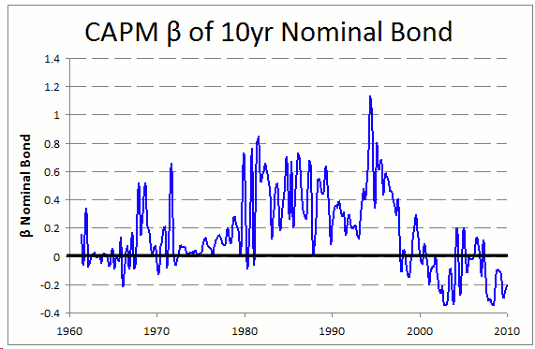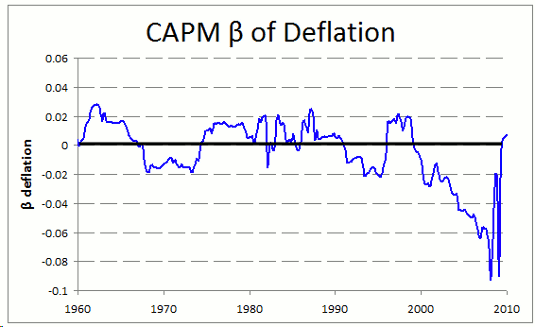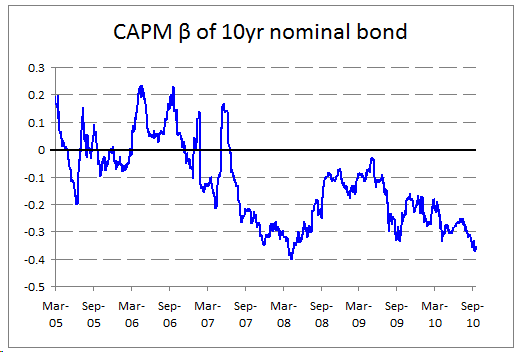By John Y Campbell, Adi Sunderam, and Luis M Viceira, first posted at VoxEU
The historically low yields on Treasury bonds are the hallmark of a bubble, according to some commentators. This column analyses the relationship between bond yields, the stock market, and inflation over the past 50 years. It finds that the riskiness of nominal bonds changes over time and that investors and policymakers can use the changing stock-bond correlation as a real-time measure of inflation expectations.
The yields on government bonds are at their lowest levels since the depths of the financial crisis in late 2008. On Monday 18 October, the yield on 10-year Treasury notes hit 2.52%, down from 3.85% at the beginning of the year. This movement is huge by the standards of the Treasury market. An investment in 10-year Treasury notes has returned about 11.4% this year.
Moreover, nominal bonds are exposed to inflation risk. Given that the use of unconventional monetary policy has increased uncertainty about inflation (e.g. Taylor 2009), one might expect investors to regard bonds as particularly risky and demand high yields (low prices). The persistence of historically low yields in the face of such risks has led some commentators, notably Siegel and Schwarz (2010), to suggest there is a bubble in the government bond market.
Bond valuation and risk
What determines how much investors are willing to pay for nominal bonds? There are three critical factors:
* expected inflation,
* real interest rates, and
* risk premia.
Since inflation erodes the real value of the payments bond investors receive, they must adjust prices for expected inflation to earn their target real interest rate. In addition, bonds are risky because realised inflation and interest rates can turn out to be different than investors’ expectations. Risk premia are compensation for bearing this risk.
In recent work, we examine how the riskiness of bonds varies over time (Viceira 2010; Campbell et al. 2009). In particular, we argue that inflation makes bonds risky at certain times, while giving them insurance, or hedge, value at others. For instance, if inflation rises unexpectedly when economic conditions deteriorate, the real value of bond payments falls unexpectedly. In this case, bond investors sustain losses when they likely need funds, and bonds are risky assets that investors should charge a risk premium for holding.
In contrast, if inflation falls unexpectedly when economic conditions deteriorate, bonds are like insurance, providing a windfall at the time investors need it the most. Bond investors should be willing to pay for this insurance value, just as they are willing to pay for other types of insurance. In this case, the inflation risk premium should actually be negative.
Historical evidence
The idea that the riskiness of nominal bonds changes over time is consistent with the evolution of conventional wisdom among investors. In the late 1970s and early 1980s, investors regarded bonds as risky. The famous bear Henry Kaufman, also known as “Dr. Doom”, argued that investors should completely avoid bonds unless they offered high risk premia. In contrast, by the early 2000s investors had come to regard bonds as a safe haven against the risk of a Japan-style episode of deflation.
This conventional wisdom is broadly consistent with the lessons of financial economics. In particular, the Capital Asset Pricing Model (CAPM) uses the stock market as a proxy for economic conditions. This suggests a simple metric for the riskiness of an asset: how its returns co-move with stock market returns. Risky assets do poorly at the same time the stock market does poorly, causing investors to sustain losses at the worst possible moment. Such assets should have large risk premia to compensate investors for this risk. In contrast, safe assets do well when the stock market does poorly, adding insurance or hedge value to investor portfolios. These assets require small or even negative risk premia.
Figure 1. Stock and bond returns over time

Figure 1 plots the co-movement of stock and bond returns over time. The intuitions of the CAPM are broadly consistent with the way investors have historically viewed bonds. In the late 1970s and 1980s, stock and bond returns co-moved positively. When stocks did poorly bonds also did poorly, consistent with the idea that they were risky. By the 2000s, stock and bond returns co-moved negatively, suggesting that bonds had become safe havens.
Figure 2. Bond returns and inflation over time

Figure 2 shows that the behaviour of bond returns is related to the behaviour of inflation by plotting the historical co-movement of stock returns and inflation. Since inflation is bad for bond returns we invert the graph. The pattern is very similar to the co-movement of bond returns and stock returns: positive in the 1970s and 1980s and negative in the 2000s.
Thus, it appears that the changing risks of nominal bonds are related to the changing relationship between inflation and economic growth. When inflation is procyclical, as it was in the 1960s and 2000s, inflation falls at the same time that unemployment is rising and growth is falling. During these periods, stocks and nominal bonds are negatively correlated and nominal bonds hedge deflation risk. In contrast, when inflation is countercyclical, as it was in the 1970s and 1980s, inflation rises as unemployment rises and growth falls. In an environment of stagflation, stocks and nominal bonds are positively correlated and nominal bonds are risky.
Implications for the current environment
What can this model for bond prices tell us about the world today? Figure 3 shows the co-movement of stock and bond returns, our measure of riskiness, over the last five years. The series turned sharply negative once the financial crisis began in mid-2007, briefly returned towards zero by mid-2009, and has again been quite negative over the past year.
Figure 3. Stock and bond returns and riskiness over time

The stock-bond correlation implies that investors currently view government bonds as a hedge against the possibility of deflation and low growth. Though they may be uncertain about the direction of inflation over the next five years, investors appear to believe that any increase in inflation will likely be accompanied by growth, making it less painful for their portfolios.
In evaluating the current level of bond prices, the critical question is whether investors are correct. If inflation will indeed be accompanied by growth, then nominal bonds should carry a negative inflation risk premium and correspondingly high prices. However, it is also possible that the economy could enter a period of stagflation with high inflation and low growth. In this case, investors should be charging a higher inflation risk premium, and bond prices should be lower today.
Our work also has important implications for policymakers trying to use financial data to understand inflation expectations. First, policymakers can use the stock-bond correlation as a “canary in the coalmine.” If the correlation starts to turn positive, policymakers will know that investor anxiety about stagflation is rising. They can then take steps to keep inflation expectations well-anchored.
Second, policymakers often use break-even inflation, the difference between the yields on nominal and inflation-indexed bonds (TIPS), as a proxy for market inflation expectations. However, this quantity is actually the sum of expected inflation and the inflation risk premium. Thus, if the inflation risk premium is negative, breakeven inflation understates market inflation expectations. The negative correlation between stocks and bonds today suggests that the inflation risk premium on Treasuries is negative, and it could be as low as -75 or -85 basis points. This implies that investor expectations of 10-year inflation reflected in the bond market are around 2.7%, in line with the view of professional forecasters and the inflation swap market.
Conclusions
Financial market data suggest that investors expect inflation to be moderate and procyclical going forward. However, the behaviour of inflation has changed in the past and may do so again. Investors and policymakers alike can use the stock-bond correlation as a real-time measure of inflation expectations.


Thank you for this timely post. It is vastly confusing to this non-economist. Considering there is no ‘safe haven’ for individuals real liquid savings against inflation; one wonders what the VALUE of particular bonds (especially TIPS) are.
If the CPI was gauged to reflect the everyday and ordinary purchases of individuals in NEEDS of their lives such as fuel, food, insurance, etc. then perhaps bonds might be an investment strategy. Additionally, the federal reserve is buying treasury bonds, which clouds the price support picture further.
The federal reserve has pulled out all the stops to support the financial industry, fight disinflation. The expectation that the banks will cut loose their hoarded reserves of cash is low in adding that source into money supply and velocity; therefore, broad inflation is not an expectation from this source if past performance is any indicator. The vast liquidity sloshing around trying to find a yield around the world isn’t the problem. It is about leverage and it is about more elemental parts of the economy still ignored that will keep growth sluggish to nil.
One source of inflation is monetary policy and dollar strength/weakness. Another source could be covert and/or overt tariffs or trade wars. These stresses threaten stag-flation more than other previous policy/monetary actions.
Risk appetites for individuals is very low. I realize this article is targeted to professionals in finance.
Until basics long ignored in the natural economy are effectively addressed no amount of alchemy will be adequate. Jobs that pay a living wage with benefits and the ability of people to live their lives without fear and without govt. sponsored private and ‘free-market’ predatory agents sucking out what little true wealth is gained is required.
Restore Glass-Steagall and Repeal the CFMA.
Not just a living wage, but certain sectors of the economy should be off limits to rapacious swindlers and profiteers. That would include healthcare, housing, and good to name a few. Those who can afford it could go outside the socialized sector, but we really need a strong safety net for those who can’t.
The bond market is an encrypted skim scam casino shell game where the central bankers have the encryption keys. The good old fashioned Profit Driven Vanilla Greed game has been changed and the old players are now getting their clocks cleaned by the new operators, the Control Driven Pernicious Greed crowd, that have incrementally changed the game — control now trumps profit!
Say hello to deflationary herd thinning perpetual conflict and good bye to good old fashioned Profit Driven Vanilla Greed. Expect rolling bond bubbles as required to effect the new Control Driven Pernicious Greed policy.
The casino expands as we speak …
http://www.marketwatch.com/story/beijing-to-allow-banks-expanded-bond-trading-2010-10-27
Deception is the strongest political force on the planet.
I stopped reading as soon as CAPM started being mentioned.
Puleeze! More fairy dust economics in a pseudo profession.
Any discussion of the factors driving Treasury bond prices over the last couple of years which doesn’t include POMO seems to me to be detached from reality. When I buy a Treasury bond, as I do every month or so, I have no doubt that my yield (if there is any) was largely set by good old Ben, not by any magical elixir of efficient market forces.
Couldn’t understand a word of this. Do they agree with Siegel and Schwarz or not? Please explain in plain English.
I can not comment to this, does anybody have any idea why?
Seems to be you.
Grace, just testing to see if it you or them.
I agree with most of the comments here. Stock markets are rigged and are experiencing their own bubble. In such an environment, do “expectations” upon which all this is premised even have a meaning?
The one thing we can say about markets is that they do not reflect broader economic conditions. This makes the use of the CAPM to put it mildly problematic.
But do we even need this pointless overlay to know that chances for rapid growth are zero. Add in Helicopter Ben’s policies and is it any surprise that even in highly distorted markets bond yields are where they are and where they are likely to remain?
I always find it twisted when risk compensation can only be properly determined afterward.
“If inflation will indeed be accompanied by growth, then nominal bonds should carry a negative inflation risk premium and correspondingly high prices. However, it is also possible that the economy could enter a period of stagflation with high inflation and low growth. In this case, investors should be charging a higher inflation risk premium, and bond prices should be lower today.”
This totally negates the idea of risk. If you knew what was to happen, there wouldn’t be any risk, and you couldn’t charge for it. Since you don’t know what will happen, you can’t charge for varying degrees of risk depending on what might happen. In fact, the idea of charging for risk at all is misleading and inaccurate.
Sell a bond at a price. If no one wants to buy it because, say, the current rate of CPI inflation is the same as the interest on the bond, so be it. Adjust the price. Risk is an entirely personal estimation, and can not be institutionalized into a calculated premium. To do so is a lie, and it is probably worth looking into that lie to see what it is covering up.
This article appears to buy into the dogma of obfuscation.
Hm… Well, I’m guessing the poster is right, but I don’t really need an fancy charts or “facts” to back it up. I mean, basically, with so few things out there making any return at all, anything that makes a return is going to attract a lot of desperate investors. (This is probably a great time of scams too, which the markets, these days, may be anyway.) Thus, there is probably just an inherent risk right now that just about everything, with a return, is a bubble. Buyer beware.
“Financial market data suggest that investors expect inflation to be moderate and procyclical going forward. However, the behaviour of inflation has changed in the past and may do so again. Investors and policymakers alike can use the stock-bond correlation as a real-time measure of inflation expectations.”
In other words, we have no idea. We REALLY want there to be inflation without growth, because then there are more bubbles to play with.
Because bubbles are fun. Real Growth? Not so much….